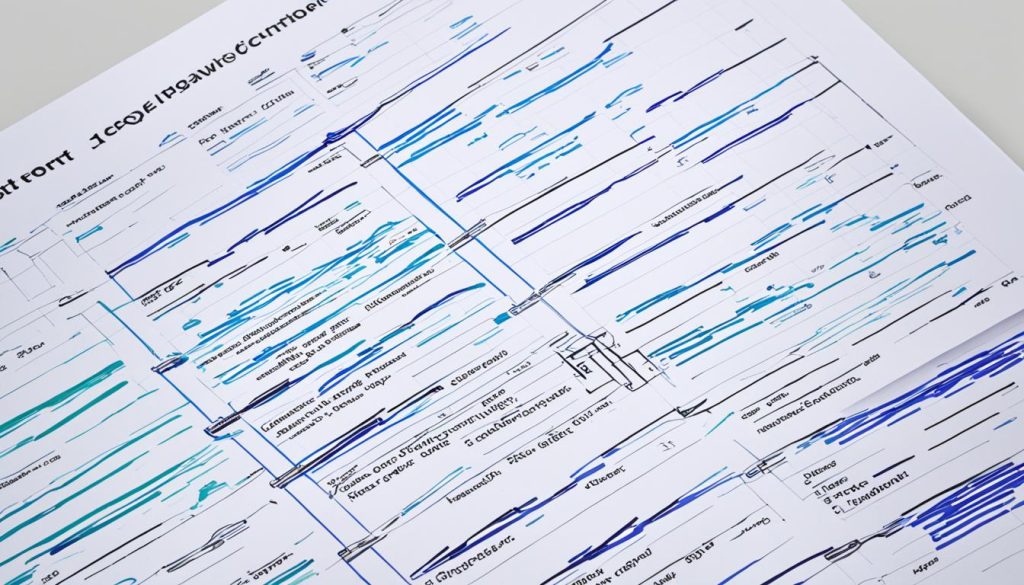Streamlining business processes is essential for achieving operational excellence and maximizing business efficiency. With Snap Business Manager, organizations can take control of their operations and streamline management for optimal performance. By leveraging the power of this comprehensive management solution, businesses can enhance productivity, improve communication, and drive growth.
With Snap Business Manager, businesses can map existing process workflows, analyze bottlenecks, and identify areas for improvement. By optimizing processes, introducing new workflows, and documenting progress, organizations can achieve streamlined management and operational excellence. The benefits are clear – time-saving, cost efficiency, better communication, clear documentation, and the ability to identify and address obstacles that hinder business growth.
Integrating methodologies like business process management, customer relationship management, and project management software, along with specialized tools for HR, marketing, finance, legal, and accounting, Snap Business Manager offers a comprehensive solution to streamline processes and drive operational efficiency. With its user-friendly interface and customizable features, this management tool empowers businesses to achieve their goals, minimize waste, and ensure a consistent and effective workflow.
Key Takeaways:
- Streamlining business processes is essential for achieving operational excellence and maximizing efficiency.
- Snap Business Manager enables organizations to map existing workflows, optimize processes, and drive productivity.
- By leveraging methodologies and specialized tools, businesses can achieve streamlined management and operational efficiency.
- Snap Business Manager offers a user-friendly interface and customizable features, empowering businesses to achieve their goals.
- With Snap Business Manager, organizations can minimize waste, improve communication, and drive growth.
The Importance of Document Workflow in Operational Efficiency
Document workflow plays a vital role in maximizing operational efficiency within businesses. By streamlining document workflow, organizations can optimize various aspects of their operations, leading to improved productivity and overall business performance.
One of the key benefits of streamlining document workflow is the significant time savings it offers. By eliminating unnecessary steps and reducing search time, employees can access the required documents quickly and efficiently. This not only saves time but also enhances collaboration among team members.
Reducing errors is another crucial advantage of optimizing document workflow. Through defined review and approval processes, organizations can ensure that documents are accurate and error-free, minimizing the risk of operational inefficiencies caused by mistakes.
Document workflow optimization also plays a crucial role in enhancing security and compliance. By enforcing measures such as access controls, encryption, and audit trails, organizations can protect sensitive information and maintain regulatory compliance.
Moreover, optimizing document workflow enhances customer satisfaction. Prompt access to up-to-date documents enables businesses to respond quickly to customer inquiries and requests, resulting in better customer service.
Additionally, streamlining document workflow supports effective knowledge management within organizations. By organizing and categorizing documents, valuable knowledge and information can be easily accessed, shared, and utilized, improving overall productivity.
In summary, streamlining document workflow positively impacts operational efficiency in several ways. It reduces manual effort, improves information management, enhances collaboration, ensures compliance and security, and supports overall productivity. By investing in document management and workflow optimization, organizations can streamline their operations and achieve higher levels of efficiency, ultimately driving better business outcomes.
Benefits of Document Workflow Optimization
| Benefits | Description |
|---|---|
| Time Savings | Elimination of unnecessary steps and reduced search time |
| Improved Collaboration | Access to up-to-date documents and reduced errors through review processes |
| Enhanced Security and Compliance | Enforcement of measures and provision of an audit trail |
| Increased Customer Satisfaction | Prompt responses and efficient customer service |
| Effective Knowledge Management | Organizing and categorizing documents for easy access and utilization |
Strategies for Streamlining Document Workflow
When it comes to streamlining document workflow and optimizing operational efficiency, there are several strategies organizations can employ. These strategies include agile workflows, business process improvement, business process reengineering, lean strategies, Six Sigma, Theory of Constraints, and Total Quality Management. By implementing these methodologies, businesses can achieve workflow optimization, reduce bottlenecks, decrease waste, improve productivity, enhance agility, and foster consistent and effective collaboration.
Agile Workflows
Agile workflows place emphasis on interaction, collaboration, and adaptability. By breaking down tasks into manageable units and encouraging regular feedback, agile workflows enable teams to respond swiftly to changes, identify and rectify issues promptly, and achieve streamlined document workflows.
Business Process Improvement
Business process improvement involves identifying and improving less efficient parts of a process. By analyzing existing workflows and identifying areas for enhancement, organizations can implement changes that result in optimized document workflows and improved operational efficiency.
Business Process Reengineering
Business process reengineering takes a more radical approach by redesigning workflows from scratch. This strategy aims to eliminate unnecessary steps, simplify processes, and leverage automation technologies to create streamlined and efficient document workflows.
Lean Strategies
Lean strategies focus on reducing waste and streamlining processes. By eliminating activities that do not add value, optimizing resource allocation, and continuously improving workflows, organizations can achieve lean document workflows that maximize efficiency.
Six Sigma
Six Sigma is a data-driven methodology that aims to identify and eliminate root causes of process deficiencies. By using statistical analysis and rigorous problem-solving techniques, organizations can achieve error-free document workflows that enhance operational efficiency.
Theory of Constraints
The Theory of Constraints addresses factors that limit goal achievement. By identifying and resolving bottlenecks and constraints in document workflows, organizations can optimize resource utilization, improve throughput, and achieve streamlined and efficient operations.
Total Quality Management
Total Quality Management focuses on continuously improving processes through error reduction, standardization, and employee involvement. By fostering a culture of quality and implementing effective quality control measures, organizations can achieve document workflows that consistently meet or exceed customer expectations.
Incorporating these strategies into their document workflows, organizations can unlock their full potential for operational efficiency and achieve their business goals.

Benefits of Workflow Optimization
Workflow optimization offers several benefits to organizations. By implementing efficient processes, businesses can improve customer relationships, enhance productivity, and promote a positive work culture that values consistency and collaboration. Let’s explore the key advantages of workflow optimization:
Improved Customer Relationships
Workflow optimization plays a crucial role in strengthening customer relationships. By streamlining processes, businesses can provide timely responses, ensure customer satisfaction, and deliver high-quality products or services. Through efficient workflows, organizations can create a customer-centric environment that fosters loyalty and trust.
Increased Efficiency and Reduced Delays
One of the primary goals of workflow optimization is to identify and eliminate bottlenecks. By streamlining processes and identifying areas of waste, organizations can increase operational efficiency and reduce unnecessary delays. This enables teams to complete tasks more swiftly and enhance overall productivity.
Cost Savings and Streamlined Processes
Workflow optimization eliminates unnecessary steps and reduces waste, leading to cost savings for organizations. By streamlining processes, businesses can identify areas of inefficiency and implement strategies to eliminate unnecessary expenses. This streamlined approach improves resource allocation and overall operational effectiveness.
Enhanced Productivity
Optimized workflows allow employees to focus on value-added tasks by eliminating redundant or low-value activities. By automating manual processes and standardizing workflows, organizations can ensure that employees can dedicate their time and energy to tasks that contribute directly to business growth and success. This increased productivity drives innovation and supports continuous improvement.
Greater Agility
An optimized workflow enables organizations to adapt quickly to changing circumstances and seize growth opportunities. By implementing flexible processes, businesses can respond effectively to market changes, emerging trends, and customer demands. This agility allows organizations to stay competitive and responsive in a dynamic business environment.
Consistency and Collaboration
Workflow optimization promotes consistency in processes, ensuring that every task is executed to a high standard. Standardized workflows enable employees to align their efforts, driving teamwork and collaboration across departments and teams. This consistency fosters open communication and knowledge sharing, facilitating better decision-making and problem-solving.
Improved Compliance and Multitasking Capabilities
Workflow optimization involves standardizing processes to ensure compliance with industry regulations and internal policies. By implementing consistent workflows, organizations can minimize errors, mitigate risks, and demonstrate a commitment to compliance. Additionally, optimized workflows enable employees to handle multiple tasks simultaneously, enhancing their multitasking capabilities and overall efficiency.
Enhanced Work Culture and Reduced Stress Levels
A streamlined workflow contributes to a positive work culture by reducing stress levels and improving work-life balance. By eliminating unnecessary administrative tasks and promoting efficiency, organizations create a work environment that values employee well-being and promotes a healthier work-life balance. This leads to greater job satisfaction and reduced stress levels among employees.

| Benefits of Workflow Optimization |
|---|
| Improved customer relationships |
| Increased efficiency and reduced delays |
| Cost savings and streamlined processes |
| Enhanced productivity |
| Greater agility |
| Consistency and collaboration |
| Improved compliance and multitasking capabilities |
| Enhanced work culture and reduced stress levels |
Conclusion
Workflow optimization is a crucial practice for achieving operational excellence. By streamlining business processes and document workflows, organizations can improve efficiency, reduce waste, enhance collaboration, and achieve better outcomes. Implementing strategies like agile workflows, business process improvement, business process reengineering, lean strategies, Six Sigma, Theory of Constraints, and Total Quality Management can lead to significant improvements in operational efficiency.
Workflow optimization brings a plethora of benefits to organizations. It fosters improved customer relationships through timely responses and enhanced satisfaction. By decreasing bottlenecks and waste, workflow optimization increases productivity and efficiency. It also promotes greater agility, allowing organizations to adapt to changing market demands. Workflow optimization enhances work culture and collaboration, creating a positive and cohesive environment that drives employees to excel. Furthermore, it ensures better compliance and enables organizations to multitask effectively, leading to streamlined processes and reduced stress levels among employees.
Organizations should continuously review and optimize their workflows to create a streamlined and efficient operational environment. By doing so, they can stay competitive, achieve their business goals, and strive for operational excellence. Workflow optimization is not a one-time task but an ongoing practice that enables organizations to adapt to the ever-changing business landscape and deliver outstanding results.




No comments! Be the first commenter?